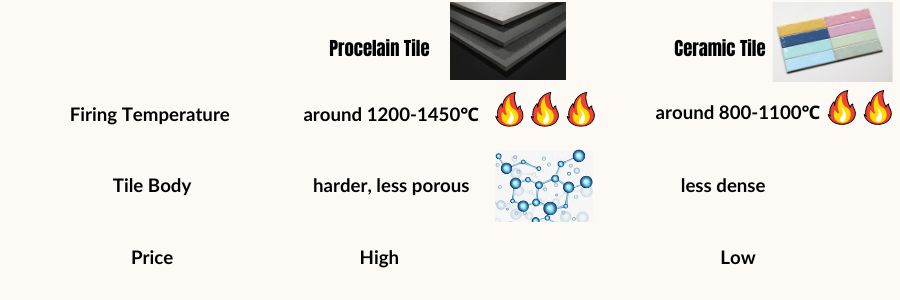Are you trying to decide between porcelain and ceramic tiles for your project? With so many different styles, colors, shapes, and sizes available, it can be difficult to know which type of tile is best suited for your project. Luckily, this guide is here to help! We’ll provide a detailed comparison between the pros and cons of both ceramic and porcelain tiles, enabling you to make an informed decision that suits your needs. So whether you’re looking for a classic and timeless look or something more contemporary, this guide has got you covered! Let’s dive in and explore porcelain vs ceramic tile comparison guides!
Porcelain and ceramic tiles can both be used for a variety of applications, from floors to walls, countertops, and backsplashes. However, there are some fundamental differences between these two materials that must be taken into account before making a decision.
So, let’s talk about the porcelain tiles first.
I. What Is Porcelain Tile?
Porcelain tile is a type of tile that’s made from a mixture of clay and other mineral materials, such as kaolin, quartz, and feldspar. And then fired at high temperatures ( more than 1250 degrees) to create the tiles with high density and low water absorption character. It absorbs less than 0.5% of the water.

II. Pros And Cons Of Porcelain Tile
Exploring porcelain tile requires weighing its merits against its drawbacks to see if it meets your specific needs. Let’s review its key advantages and disadvantages.
Porcelain Tile Advantages:
Porcelain tiles stand out in residential and commercial spaces for their:
- Durability & Scratch Resistance: Crafted from refined clay and fired at high temperatures, they boast exceptional durability and scratch resistance, ideal for high-traffic areas.
- Strength: They exhibit superior strength and hardness, minimizing damage or cracks.
- Waterproof: Their low water absorption rate makes them perfect for wet areas like bathrooms, kitchens, and patios, enduring against weather without cracking.
- Easy Maintenance: With low porosity, they resist stains and are effortlessly cleaned, supporting the use of stronger cleaning agents without aesthetic loss.

Porcelain Tile Disadvantages:
However, considering the full picture reveals some drawbacks:
- Cost: Porcelain is pricier than ceramic due to its high-quality materials and manufacturing processes, potentially straining tight budgets.
- Installation Challenges: Its dense material makes installation and cutting complex, possibly requiring professional tools, particularly for intricate designs or large tiles.
- Peeling Off Issues: While its waterproof nature is generally a plus, it might hinder proper wall adhesion, risking hollow spaces behind the tile or delamination over time.
In summary, porcelain tiles offer a strong balance of aesthetics, durability, and practicality, albeit with certain challenges. For a well-rounded decision, comparing them with other materials, such as ceramic tile, is advisable.
Ⅲ. What is Ceramic Tile?
Ceramic tile is a type of tile made from clay that has been fired in a kiln at temperatures ranging from 900 and 1200 degrees, offering a distinctive choice for ceramic wall tiles and floor tiles. Unlike porcelain tiles, ceramic tiles have a lower density, making them more porous and less water resistant.

IV. Pros And Cons Of Ceramic Tile
In our exploration of porcelain tile’ pros and cons, it is equally important to gain a comprehensive understanding of ceramics’ characteristics. With this information, we will be able to make wise selections. As one of the most popular options in the market, ceramic tile has its own unique benefits and drawbacks. Now, let’s examine the particular advantages that ceramic tile offers.
Advantages Of Ceramic Tile
1. Lower Cost
The primary benefit of ceramics is their lower cost, which makes them a great choice for those budget-conscious projects.
Furthermore, the cost advantage is not limited to the initial purchase. Beyond the initial savings, their easy installation process can further cut costs, making them perfect for DIY installation.
Ceramics offer a budget-friendly option without compromising on style or functionality. They come in a wide selection of colors, designs, and patterns, that are both customizable and capable of enduring daily use, especially when glazed.
2. Light-weight, Easier To Install
Ceramic tile is also much lighter than porcelain tile, making it easier to install. This is especially important for wall applications, as it reduces the stress on walls due to the weight of the tile. It also makes them more suitable for DIY projects.

3. Easy To Cut And Drill Into Without Specialized Tools
One of the major benefits of ceramic tile is that they are easy to cut and drill into without requiring specialized tools. This feature provides a significant advantage, particularly for those who prefer a hands-on approach to home improvement projects or for professional installers looking to optimize time and efficiency.
The relatively softer material composition of ceramic tiles allows for a seamless cutting experience. Whether you’re creating intricate shapes or making minor adjustments to ensure a perfect fit, ceramics can be tailored to your specific needs with ease. This adaptability proves particularly beneficial in rooms with irregular dimensions or when dealing with complicated installations around fixtures and fittings.
Furthermore, ceramic tiles are easy to drill into for mounting items or implementing unique design accents. This characteristic is a boon for projects requiring hardware installations, such as towel bars in a bathroom or hooks in a kitchen.
Disadvantages Of Ceramic Tile
Although there are many advantages to using ceramic tile, including the natural feel and versatility of unglazed ceramic, it is also essential to be aware of their potential drawbacks, especially in terms of maintenance and care. Knowing these limitations will help us make the best purchasing decision.

1. Lower Abrasion Resistant, Not Suitable For High-traffic Areas
One fundamental disadvantage of ceramic tiles is their lower abrasion resistance, making them unsuitable for places with heavy traffic.
Due to their less decency and softer composition, ceramic tiles tend to wear down more quickly when continuously exposed to heavy foot traffic, such as in commercial establishments or busy household areas like kitchens or hallways. This attribute can lead to noticeable wear and tear over time, including scratches and faded patterns, compromising the tiles’ appearance and necessitating more frequent replacements.
2. Lower Stain Resistant, Easy To Get Dirty
Unglazed ceramic tiles are more prone to absorbing stains, posing a downside. Their higher porosity means they can easily soak up liquids like coffee or wine, leading to tough stains that mar their appearance. Additionally, ceramic tiles can quickly look dirty due to their porous nature trapping dirt, requiring more frequent cleaning to keep them looking fresh. This is especially true in high-traffic areas like entryways or kitchens, which may demand extra effort to maintain. While ceramic tiles are affordable and easy to install, their tendency to stain and hold dirt is a significant consideration.
3. Limited Temperature Resistance, Not Suitable For Outdoor Use
Finally, ceramic tiles cannot tolerate extreme temperatures as well as porcelain tiles, which makes them less suitable for outdoor use. Their porous nature and lower density mean they are more susceptible to the damaging effects of freeze-thaw cycles. In cold weather regions, ceramics can absorb water which freezes in the cold, causing the tiles to crack or break.
Additionally, exposure to intense sunlight can lead to discoloration over time, compromising the appeal of ceramic tile, and leading to an uneven appearance.
V. The Main Difference Between Porcelain And Ceramic Tile
Ceramic and porcelain tiles are popular choices for various projects due to their affordability and ease of installation. However, when comparing porcelain or ceramic tile, it’s important to note that ceramic tiles, while budget-friendly, may not be the best option for areas with high traffic or that are prone to stains due to their limited durability and stain resistance. This makes ceramic or porcelain tiles a crucial decision when planning your project, especially for outdoor applications.
Let’s explore the key differences between porcelain and ceramic tiles to offer a clearer understanding and help you decide which type of tile – porcelain or ceramic – will best meet your needs.
1). Water Absorption Difference
Water absorption is a major difference between porcelain and ceramic tiles. This feature pertains to the tile’s ability to absorb water and other liquids, which impacts its durability, stain resistance, and suitability for certain environments.

Porcelain tile, known for its low water absorption rate of typically less than 0.5%, is an excellent flooring option for moisture-prone areas such as kitchens and bathrooms. The manufacturing process involves high temperatures, resulting in a denser, slip-resistant tile body. This low porosity means porcelain tiles offer strong resistance to moisture, minimizing the risk of discoloration and damage in cold weather, making them ideal for both indoor and outdoor settings. Additionally, the glaze on porcelain tiles enhances their durability and resistance, further solidifying their status as a top choice for flooring in areas exposed to moisture.
Conversely, ceramic tiles absorb water at a higher rate—typically more than 1%. These tiles may be more prone to stains and less appropriate for locations that frequently experience moisture due to their greater porosity. Ceramic tiles could therefore not be the ideal option outside or in locations with a lot of moisture. By using the right glazes or sealants, the higher water absorption rate can be reduced and the tile’s resistance to moisture and stains increased.
In conclusion, porcelain tiles provide better moisture resistance than ceramics when taking into account the rates of water absorption. However, the decision between porcelain and ceramic will rely on the particular needs of your project, since each material has advantages and disadvantages of its own.
2). Firing Temperature Difference
The firing process is another component that plays a critical role in determining the characteristics of both ceramic and porcelain tile.

Ceramic tiles are fired at a lower temperature, typically around 1,000 degrees Celsius. This lower temperature results in a softer, less dense tile that has a higher absorption rate of water. While the lower firing temperature makes ceramic tiles easier to cut and install, it also makes them less durable and lower wearing resistant.
Porcelain tiles, on the other hand, are fired at much higher temperatures—upward ranges of 1,200 – 1450 degrees Celsius. This high-temperature firing results in a tile that is denser, harder, and less porous than ceramic tiles. The intense heat during firing vitrifies the tile, making it impervious to water and highly resistant to wear and tear. This gives porcelain tiles their outstanding durability and water-proof, making them suitable for a wide range of applications, both indoors and outdoors.
Therefore, the water absorption and firing differences between ceramic and porcelain tiles are fundamental in understanding their respective pros and cons.
3). Price Difference
The price is another significant difference when comparing porcelain and ceramic tile. As a general rule, porcelain tiles are more expensive than ceramic tiles if they are the same size.
Ceramic tiles are usually more budget-friendly. However, their higher water absorption and less durability, they might require more frequent replacement or maintenance, which could add to the overall cost over time.
In contrast, while porcelain tiles might be more expensive upfront, their durability and longevity could make them a cost-effective solution in the long run. As always, the choice between ceramic or porcelain will depend on the specific requirements, traffic, applied areas, and budget of your project.
4). Abrasion Resistance And Strength Difference
The abrasion resistance and strength are vital properties to consider when comparing porcelain and ceramic tiles due to their implications on durability.
Porcelain tiles are well-known for their exceptional strength and high abrasion resistance. This toughness stems from their manufacturing process, where they’re fired at much higher temperature. This not only vitrifies the tile, making it water-resistant, but also significantly enhances its mechanical strength. This inherent strength makes porcelain tiles highly resistant to scratches, and wears, even in high-traffic areas. This quality is measured by the PEI (Porcelain Enamel Institute) rating, with porcelain typically achieving a high PEI rating, normally PEI rating 3-PEI 5, indicating substantial resistance to surface wear.
Ceramic tiles, while still a resilient flooring option, often fall short when it comes to strength and abrasion resistance. They typically have a lower PEI rating ( PEI 0 – PEI 3 ), which means they are not the ideal choice for areas with high footfall or heavy traffic use. They are more suitable for wall or the resident floor, such as bedrooms or laundry rooms.

5). Installation Process Difference
The installation process is another key difference between porcelain and ceramic tiles, primarily because of the distinct physical properties of each material.
Porcelain Tiles:
Installing porcelain tiles can be a bit more complex due to their density and hardness. This density makes them more difficult to cut, often requiring a wet saw with a diamond blade. Additionally, because of their weight, they might require a stronger adhesive to ensure they stay in place. When installing porcelain tiles, it’s important to ensure that the surface is clean, level, and dry, as any imperfections can cause issues down the line. Due to these factors, installation might take longer and cost more, especially if professional installers are required.
Ceramic Tiles:
On the other hand, ceramic tiles are generally easier to cut and install, they’re a popular choice for DIY projects. Since their lower density, you can use simple tile cutters, like a manual tile cutter, instead of needing specialized tools. Ceramic tiles also tend to be lighter, so they don’t require as strong an adhesive as porcelain tiles. The difference between porcelain tile is, ceramic tile needs to be soaked in the water before installation.
In conclusion, while both types of tiles can create beautiful styles, their installation processes differ. If you’re looking for a DIY-friendly option, ceramic might be the way to go. If you need something more durable and water-resistant, and you don’t mind the potential for higher installation costs, porcelain could be the better choice. Always consider the specific needs of your project when choosing between porcelain and ceramic tiles.
VI. Ceramic Vs Porcelain Tile, How To Choose The Right Materials For Your Project
Tiles are affordable, durable, come in various styles, and are easy to clean and maintain. They are an excellent option whether for wall and floor tiles.
If you are still not sure about choosing porcelain or ceramic tiles, you may make a more informed decision by taking into account the following aspects: such as the paving scene, the tile’s water absorption, wear resistance, style design, size, slip resistance, surface effect, budget and installation process, among other things.
Porcelain tiles are extremely durable and waterproof making them suitable for all floors, outdoor applications, wet regions, and high-traffic areas. However, they can be more expensive.
Ceramic tiles are usually more budget friendly and easier to install. Furthermore, their lighter weight makes them suitable for use as wall tiles or in the light traffic residential spaces.
For your project, you can also choose materials according to different wear resistance levels (PEI ratings). Based on the anticipated wear and tear in your particular use case, select the tile product that best meets your demands. For example: If your project is a hotel lobby or a restaurant with heavy foot traffic, porcelain tile will be stronger and more resistant to wear than ceramic tile. And if your project is for a bathroom wall, you can use either ceramic or porcelain tile. And ceramic tile is less expensive than porcelain tile when it comes into price, and installation cost.
Conclusion
In conclusion, both ceramic and porcelain tiles have distinct advantages, and the choice between those two types is mostly determined by the specifications of your project. Porcelain tiles are ideal for high-traffic and wet areas due to their abrasion and water resistance, whereas ceramic tiles are popular for wall coverings and light-traffic areas due to their simplicity of installation and cost-effective cost. To make an informed decision, consider aspects like as durability, abrasion resistance, design, pricing, and installation technique.
We have already discussed the distinctions between ceramic and porcelain tiles, along with how to make a decision. It’s now up to you to take action!





One Response